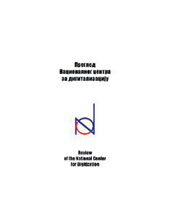Issues
Review of the National Center for Digitization
Publisher: Faculty of Mathematics, University of Belgrade
ISSN: 1820-0109
Issue: 32
Year: 2018

FRAMEWORK FOR FUZZY CLASSIFICATION OF DIGITIZED DOCUMENTS
Aleksandar Janjić
Abstract
The classification of a text document with respect to a predefined set of classes is an
assignment of one of the values 0 or 1 to each ordered pair (document, class), depending on whether the
document belongs to the class or not. Fuzzy classification generalizes this notion by enabling the membership
to be expressed by any real number between 0 and 1. In this paper, we show one possible method of fuzzy
classification by using the existing formulas for calculating the distance of a document from a class. As an
illustration, we use this method to form a fuzzy classification of a subset of documents from Ebart-hier
corpus. After that, we briefly describe the current state of the National Center for Digitization virtual library
and show by an example how fuzzy classification can be used to improve the organization of the Library data
and extend the querying possibilities.
1 - 26
COMBINING AIRBORNE AND TERRESTRIAL LASER SCANNING IN PRESERVATION OF CULTURAL HERITAGE
Jovana Radović, Vladimir Pajić, Dragana Popović, Miro Govedarica, Stevan Milovanov
Abstract
Cultural heritage is an important factor in the life of every human being. It helps us to
understand previous generations as well as the history of where we come from. In order to save cultural
heritage for next generations, there is a need for their preservation. The main purpose of this paper is to
show aspects concerning combining two technologies for acquisition and documenting of historical
objects for preserving purposes. The recent development of computer and information technologies
caused replacement of traditional acquisition methods with nowadays popular technologies. The paper
also describes the principle of these technologies, terrestrial laser scanning (TLS), aerial laser scanning
(ALS) and their main products. Advantages provided by these technologies are fast acquisition, very
dense 3D point clouds with high accuracy and also a very short period of time for its processing. Riegl
LMS – q680i and Leica ScanStation P20 3D laser scanner were used for surveying the area of
Petrovaradin old town in Novi Sad, Serbia. Processing of raw data includes integration of two point
clouds into one, noise filtering, meshing and drawings of the facade. The final step after processing of the
data for Petrovaradin old town was a publication on the web in the form of panoramic images and point
cloud viewer. In that way, anyone interested can view the data, perform measurements, draw cross
sections or make a simple analysis. This project is a part of a (larger) project with the final model of
complete area of Novi Sad.
27 - 33
MEMORIAL ISSUE OF THE DOMAĆI LIST: ILUSTROVANI ČASOPIS ZA NARODNU PRIVREDU, POUKU I ZABAVU (1890-1893)
Gabrijela Zambo, dr Vladimir Jerković
Abstract
The City Library Karlo Bijelicki, through the Digital Library of Serbia portal and the Digital
Sombor project presents the chosen corpus, available without any fee or restrictions to the users of the library.
In this paper, editors of the memorial issue of the Domaći List present how difficult, on the one side, but also
interesting, on the other side is to edit paper from the end of the 19th century and how important to culture is
to preserve the memory of the past. The publication of the memorial issue required detailed analysis of all the
issues of the Domaći List, beginning with the first issue that was published in 1890 until the last double issue
(23/24) from 1893. Publication is planned for this year, along with the digitalizes issues which will be
uploaded on the official website of the City Library Karlo Bijelicki.
34 - 39
MILAN J. ANDONOVIĆ (1849 -1926)
Ivana Ilić
Abstract
Milan Andonović was one of the first Serbian authors who published a manuscript in the field of
Probability and Statistics, a man who is considered to be the actuator of a cadastre implementation and a
scientist who significantly influenced on the astronomy and the science in general in Serbia toward the end of
XIXth century. In this paper we give a short review of his biography, on his scientific contributions and
digitized books deposited in the Virtual Library of the Faculty of Mathematics in Belgrade.
40 - 46
ANALYSIS OF A DIGITIZED COLLECTION OF SOLVED PROBLEMS OF GENERAL ASTRONOMY BY VOJISLAV MIŠKOVIĆ
Viktor Radović, Vladimir Đošović
Abstract
The first collection of solved astronomical problems written in Serbian is „Zbirka zadataka iz opšte
astronomije“ (A collection of solved problems of General Astronomy) written by professor Dr Vojislav
Mišković. This collection of solved problem was divided in two separate books due to technical reasons. The
first one was published in 1956. in Belgrade, while the second is still in form of a manuscript. Both of them have
been digitized and are available in the Virtual Library of the Faculty of Mathematics. More than 60 years have
passed since this problem book has been published which gives us an opportunity to analyze differences between
given solutions and todays approaches, and also to note importance of this problem book as part of Serbian
history of astronomy and science in general.
47 - 52